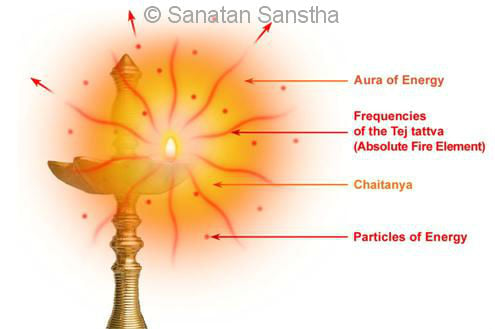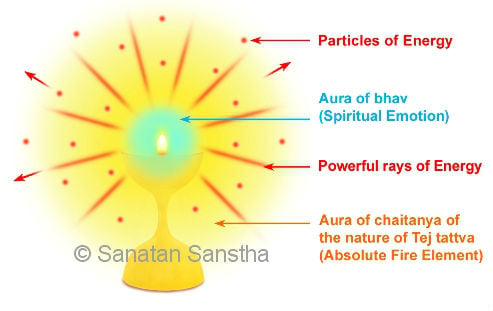![]() What does this mean? It means that if you have faith in the Sathguru, you'll see God. This is a fundamentally profound symbolism in jothi worship taught by the Arunachala Siddha, Sathguru Venkataraman.
What does this mean? It means that if you have faith in the Sathguru, you'll see God. This is a fundamentally profound symbolism in jothi worship taught by the Arunachala Siddha, Sathguru Venkataraman.
Agni Puran clearly states that only oil or Ghee (clarified butter) be used in the lamp meant for puja and no other combustible substance. According to the Science of spirituality the lamp with clarified butter is more sattvik(spiritually pure) as compared to lamp in which oil is used. This is an important aspect which we will try to understand in details. So let us see the difference between the the lamp in which Ghee is used and the one with oil.
Generally the use of oil is more prevalent than that of Ghee. The oil containing lamp kindles longer while the ghee containing lamp kindles for a short period. Now let us see the difference from the spiritual view point.
Ghee lamp has more capacity to attract the sattvik vibrations present in the surrounding atmosphere as compared to oil lamp.
The oil lamp can attract the sattvik vibrations spread over a maximum distance of 1 meter while the ghee lamp can attract sattvik vibrations spread over till Swarga Lok (heaven)
* When the oil or ghee gets exhausted or the lamp stops burning for some other reason then both the oil and ghee lamps are affected at spiritual level to some extent.
When the oil lamp stops burning the predominance of raja particles in the atmosphere is enhanced and lasts for half an hour. On the other hand when the ghee lamp stops burning the impact of sattvikta (the quality of being sattvik) on the atmosphere is experienced even after four hours.
Now let us see the characteristics of kindled lamps containing oil and ghee from spiritual angle with the help of a subtle drawing. Here we have to take into consideration the fact that while the vibrations of a subtle drawing are three dimensional we see them in the subtle drawing in a two dimensional form. For example the sphere will appear as a circle. Now let us look at the subtle drawing:
 |
The yellow coloured circles seen in this drawing emit divine consciousness (chaitanya) in the atmosphere. The red coloured circles are of radiant energy. The burning flame is emitting frequencies full of Tej tattva (absolute fire principle) in the atmosphere. The red particles which you see here are the emitted particles of energy. So you have seen in this drawing how a oil lamp emits energy in the atmosphere. Now let us observe the subtle drawing of ghee lamp. The blue colour just besides the flame is indicative of spiritual emotion (bhav). The yellow circles which you see here are of chaitanya in the form of Tej tattva projecting in the atmosphere. You can also see the red particles and rays consisting of energy projecting into atmosphere.
 |
Two Wicks at a minimum
![]() Since the family unit is centered around a woman and a man, Sathguru Venkataraman says that we must light a minimum of two lamp jothis in this worship procedure, one to represent the woman and the other to represent the man, thus symbolizing the family unit which is fundamental in spirituality.
Since the family unit is centered around a woman and a man, Sathguru Venkataraman says that we must light a minimum of two lamp jothis in this worship procedure, one to represent the woman and the other to represent the man, thus symbolizing the family unit which is fundamental in spirituality.
![]() It's ideal if you can light two lamps with a wick in each, but if you want to make do with just one lamp, then light two wicks in that lamp.
It's ideal if you can light two lamps with a wick in each, but if you want to make do with just one lamp, then light two wicks in that lamp.
More than two wicks is good
Which Oil to Use
Pancha Deepa Oil
Ohm Siva Siva Ram Ram Ohm. Here are two of our Siddha ways of making Pancha Deepa Oil using 5 different oils/extracts. This can be used for lighting lamp jothis both in home shrines(pooja room) and in temples:
"Cooling" the Lamp Jyoti
Five wicks and single wick lamp
There are other varieties of the lamps also such as lamp with a single wick and lamp called niranjan wherein five wicks are used. The Niranjan with five wicks is symbolic of duality that is the manifest energy of a deity, whereas the lamp with a single wick attracts sattvik frequencies the lamp with five wicks attracts waves with destroyer property and dominant in raja component. The niranjan with five wicks denotes the relation of Panchpran (five vital air principles) with the Atmajyoti (flame of soul). Niranjan is used for waving Pancharati. Every single flame of niranjan is symbolic of Atmajyoti. Pancharti means invocation of God with the help of panchparanas.While performing Panchartiwe should have such a spiritual emotion that the Atmajyoti is kindled in me with the help of five panchaprans present in the body and I am performing the arti with such flame.
Why should a straight wick be used as compared to puffed up wick?
Now let us understand about straight wick and wick with one end puffed up (fulwat). During puja ritual a lamp is offered at various steps of the ritual according to purpose. For example performance of arti. Two types of wicks are used in the lamp namely Puffed wick and straight wick. Nowadays a puffed wick is used in a ghee lamp or niranjanand used as lamp of worship. The wick is puffedup from below to offer it stability to stand in the center of niranjan. The puffed wick is used in a ghee lamp. This type of wick is relatively of recent origin.The second type of wick which we all are familiar with is straight wick. Two straight wicks are joined together like a thread and used in a lamp. Not only there is difference between the two on a gross form but also on spiritual level.
The lower portion of the fulwat is puffed up while the straight wick is whole like a thread.
The fulwat is representative of various raja thoughts in the mind while straight wick is symbolic of detachment and also represents the thread which joins Panchaprans with Atamjyoti.
When a fulwat is kindled the inferior deities are attracted to it while the straight wick when kindled attracts principles of higher deities.
The frequencies emitted by the fulwat are of circular form while those emitted by straight wick are in the form of waves.
The colour of the divine consciousness emitted by the fulwat is redish yellow while that emitted by straight wick is of yellow colour.
Sattvik earth frequencies get attracted towards fulwat while more sattvik frequencies moving in the upward direction are attracted towards straight wick.
The atmospheric frequencies get momentum due to fulwat while their momentum is slowed down by the use of straight wick.
An armour of Pruthvi (absolute earth element) and Aap tattva (absolute water element) is generated around the worshipper by use of fulwat while straight wick generates an armour of Tej tatva (absolute fire element) around the worshipper.
According to science of spirituality Tej tattva is more powerful than either Pruthvi tatva or Aap tattva. As a result the use of fulwat imparts heaviness to the physical body while the use of straight imparts cheerfulness to mind.
Thus we have seen the difference between the fulwat and straight wick and also why it is important to use straight wick.
Very good information about lamp jyothi. Thank you so much for sharing. I have a doubt on "COOLING" THE LAMP JYOTI what does it mean?
ReplyDeleteNamaste, sometimes the wick completely burn and becomes black is their any significance.
ReplyDelete